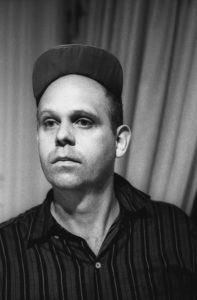CLAES OLDENBURG – ARTIST
(June 1960)

I had attended Ohio University with many accomplished talents. In the photo department: LOOK magazine and Magnum photographers Paul Fusco and James Karales, also, Newsweek photographer Robert McElroy and Judy Buswink (Ross) who went on to become a NY Times photographer in London. And in the Fine Arts department: Jim Dine. Jimmy, as he was known in the Bunch of Grapes Room of the Student Union, a darkened room with wooden booths more suitable for making-out and farthest away from the jukebox that constantly played “Sixteen Tons And What Do You Get…” Some of these people played an important part in my coming of age, though they may not have known it at the time. As a young Bronx boy, with little experience away from Morris Heights, I needed an education in fine writing and fine visual arts and this group of intellectuals were up to the task. Besides Jimmy Dine, who already was showing signs of being ahead of the curve, there was writing major, Don Moser, who went to earn a Fullbright Scholarship and later worked at LIFE magazine as a foreign bureau chief and when LIFE finally closed, became the Managing Editor of Smithsonian magazine.
On campus, Jimmy Dine was an inspirational, sometimes wild man. In his torn and hole riddled, kaki wool sweater and his shaved head, Jimmy could play a mean folk-guitar and be a happy drunk, prone to singing and dancing and gusty laughter. He took his art as seriously as his fun and no one, not one of us, thought he would fade away after graduating O.U.
Jimmy landed in New York, married to O.U. graduate Nancy Minto around 1958 and began his painting career. I babysat for their first son, Jeremiah, in their flat on Third Avenue on the Upper East Side. Their apartment hallway was lined with finished canvasses, many of them on the subject of his Jewish wedding. I also remember, sadly, that Jim offering me some of those paintings to “store” for him. “Take some of them home with you,” he offered. Of course, I was living at home with my parents in the Bronx and when I told my mom of Jimmy’s gracious offer she refused to have any of my “wild” college friend’s paintings hanging on her walls. My pleas fell on deaf ears even when I told her they were Jewish themed, with brides and grooms under chuppas and Cantors singing. She wouldn’t hear of it.

As it turned out, most of the people who had helped out Jimmy by taking care of his work wound up keeping his paintings. Dine never asked for them back. Hanging out with Jim Dine in those later years of the Fifties brought me to the Judson Gallery (part of the Judson Church) off Washington Square Park. Dine had befriended artists in the New York scene, among them, Allan Kaprow, Bob Whitman, Mark Ratliff, Bob Rauschenberg and Red Grooms. Dine had me participate in some of his Happenings and it was there that I met artist and sculptor Claes Oldenburg.
Partying was part of the fun hanging out with Dine and Oldenburg and his girlfriend and assistant, Patty Muschinski. These parties were held at various brownstones on the Westside of Manhattan. After much drinking, singing and shouting, someone would suggest a “Summit Meeting” and the drunken artists and friends would carry all the living room furniture and stack them up in a foyer. The bare, step down, living room would now be a wrestling “pit” and persons would identify themselves as being heads of state, circa 1950s. Dine, of course, with his broad shoulders and polished head would be Nikita Khrushchev. Oldenburg, by nature of his European accent, would assume the identity of Konrad Adenauer. Don Pasternak would reluctantly be Eisenhower (he didn’t vote for him), and sometimes I was tapped to wrestle as Charles DeGaulle (I wasn’t that tall; I think it was the ‘nose’). Some one, Bob Whitman or Mark Ratliff perhaps, would be Harold Macmillan.
Then, one day in 1960, Claes asked me to meet him at the new Reuben’s Gallery where he was opening this RayGun exhibition.
I photographed Claes preparing the gallery for the exhibit and though those images were never used at the time, they became iconic images published later as historical illustrations of a time once was.


Leave a Reply